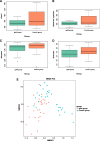Reduced fecal short-chain fatty acids levels and the relationship with gut microbiota in IgA nephropathy
- PMID: 34082732
- PMCID: PMC8173972
- DOI: 10.1186/s12882-021-02414-x
Reduced fecal short-chain fatty acids levels and the relationship with gut microbiota in IgA nephropathy
Abstract
Background: IgA nephropathy(IgAN)) is the common pathological type of glomerular diseases. The role of gut microbiota in mediating "gut-IgA nephropathy" has not received sufficient attention in the previous studies. The purpose of this study was to investigate the changes of fecal short-chain fatty acids(SCFAs), a metabolite of the intestinal microbiota, in patients with IgAN and its correlation with intestinal flora and clinical indicators, and to further investigate the role of the gut-renal axis in IgAN.
Methods: There were 29 patients with IgAN and 29 normal control subjects recruited from January 2018 to May 2018. The fresh feces were collected. The fecal SCFAs were measured by gas chromatography/mass spectrometry and gut microbiota was analysed by16S rDNA sequences, followed by estimation of α- and β-diversity. Correlation analysis was performed using the spearman's correlation test between SCFAs and gut microbiota.
Results: The levels of acetic acid, propionic acid, butyric acid, isobutyric acid and caproic acid in the IgAN patients were significantly reduced compared with control group(P < 0.05). Butyric acid(r=-0.336, P = 0.010) and isobutyric acid(r=-0.298, P = 0.022) were negatively correlated with urea acid; butyric acid(r=-0.316, P = 0.016) was negatively correlated with urea nitrogen; caproic acid(r=-0.415,P = 0.025) showed negative correlation with 24-h urine protein level.Exemplified by the results of α-diversity and β-diversity, the intestinal flora of IgAN patients was significantly different from that of the control group. Acetic acid was positively associated with c_Clostridia(r = 0.357, P = 0.008), o_Clostridiales(r = 0.357, P = 0.008) and g_Eubacterium_coprostanoligenes_group(r = 0.283, P = 0.036). Butyric acid was positively associated with g_Alistipes (r = 0.278, P = 0.040). The relative abundance of those were significantly decreased in IgAN group compared to control group.
Conclusions: The levels of fecal SCFAs in the IgAN patients were reduced, and correlated with clinical parameters and gut microbiota, which may be involved in the pathogenesis of IgAN, and this finding may provide a new therapeutic approach.
Keywords: Gut microbiota; IgA nephropathy; Short-chain fatty acids.
Conflict of interest statement
The authors declare that they have no competing interests.
Figures


Similar articles
-
Fecal microbiota characteristics of Chinese patients with primary IgA nephropathy: a cross-sectional study.BMC Nephrol. 2020 Mar 13;21(1):97. doi: 10.1186/s12882-020-01741-9. BMC Nephrol. 2020. PMID: 32169051 Free PMC article.
-
Imbalance of Microbacterial Diversity Is Associated with Functional Prognosis of Stroke.Neural Plast. 2023 May 8;2023:6297653. doi: 10.1155/2023/6297653. eCollection 2023. Neural Plast. 2023. PMID: 37197229 Free PMC article.
-
Evaluation and comparison of short chain fatty acids composition in gut diseases.World J Gastroenterol. 2019 Sep 28;25(36):5543-5558. doi: 10.3748/wjg.v25.i36.5543. World J Gastroenterol. 2019. PMID: 31576099 Free PMC article.
-
Characteristics, pathogenic and therapeutic role of gut microbiota in immunoglobulin A nephropathy.Front Immunol. 2025 Feb 6;16:1438683. doi: 10.3389/fimmu.2025.1438683. eCollection 2025. Front Immunol. 2025. PMID: 39981255 Free PMC article. Review.
-
The Role of Dietary Fibre in Modulating Gut Microbiota Dysbiosis in Patients with Type 2 Diabetes: A Systematic Review and Meta-Analysis of Randomised Controlled Trials.Nutrients. 2020 Oct 23;12(11):3239. doi: 10.3390/nu12113239. Nutrients. 2020. PMID: 33113929 Free PMC article.
Cited by
-
Metabolic Dysfunctions of Intestinal Fatty Acids and Tryptophan Reveal Immuno-Inflammatory Response Activation in IgA Nephropathy.Front Med (Lausanne). 2022 Feb 3;9:811526. doi: 10.3389/fmed.2022.811526. eCollection 2022. Front Med (Lausanne). 2022. PMID: 35186998 Free PMC article.
-
Efficacy of Lactococcus lactis subsp. lactis LY-66 and Lactobacillus plantarum PL-02 in Enhancing Explosive Strength and Endurance: A Randomized, Double-Blinded Clinical Trial.Nutrients. 2024 Jun 18;16(12):1921. doi: 10.3390/nu16121921. Nutrients. 2024. PMID: 38931275 Free PMC article. Clinical Trial.
-
Advances in research on the intestinal microbiota in the mechanism and prevention of colorectal cancer (Review).Mol Med Rep. 2025 May;31(5):133. doi: 10.3892/mmr.2025.13498. Epub 2025 Mar 21. Mol Med Rep. 2025. PMID: 40116116 Free PMC article. Review.
-
Faecal Microbiota Transplantation and Chronic Kidney Disease.Nutrients. 2022 Jun 17;14(12):2528. doi: 10.3390/nu14122528. Nutrients. 2022. PMID: 35745257 Free PMC article. Review.
-
Assessing the causal relationship between gut microbiota and diabetic nephropathy: insights from two-sample Mendelian randomization.Front Endocrinol (Lausanne). 2024 Mar 18;15:1329954. doi: 10.3389/fendo.2024.1329954. eCollection 2024. Front Endocrinol (Lausanne). 2024. PMID: 38562415 Free PMC article.
References
Publication types
MeSH terms
Substances
LinkOut - more resources
Full Text Sources
Medical
Miscellaneous

